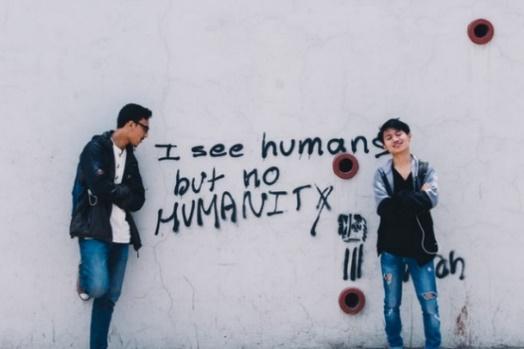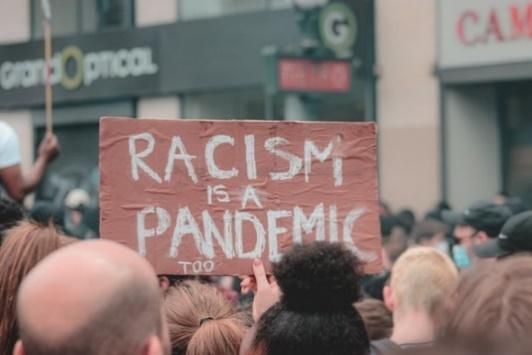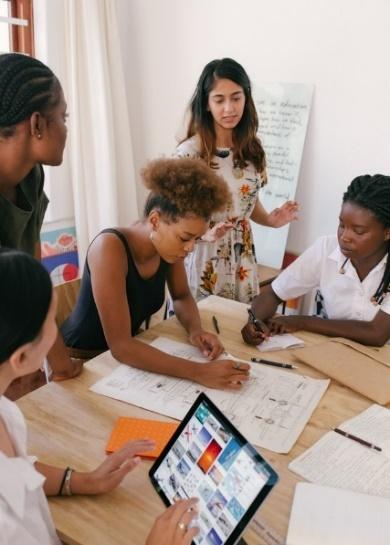1: The Significance of Ethnic Studies
- Page ID
- 145350
At the end of the module, students will be able to:
- understand the difference between race and ethnicity
- discuss the social construction of race
- explain racial framing
- compare intergroup relations in terms of racial-ethnic group conflict and tolerance
- assess systemic racism and structural explanations for racial and ethnic inequality
- evaluate the intersectionality of race, ethnicity and other social categories on systems of oppression
- provide examples of racial-ethnic stratification and inequality
- define majority (dominant) and minority groups (subordinate)
- interpret social indicators and data on racial and ethnic inequality in the United States
KEY TERMS & CONCEPTS
|
Achieved Status Ascribed Status Competition Dominant Group Double Consciousness Egocentric Ethnicity Ethnocentrism Fluid Competitive Race Relations Genocide Internal Colonialism Intersectionality Labels Macro-level Micro-level Minority Groups Multiculturalism |
Otherness Paternalistic Pattern Patterns of Intergroup Relations Pluralism Population Transfer Race Racial Disparities and Inequality Racial Formation Rigid Competitive Pattern Segregation Social Status Sociocentrism Status Shifting Stratification Subordinate Group Systemic Racism Unequal Power |
INTRODUCTION
Have you ever had your experience or story misrepresented or retold in an inaccurate way?
Has anyone ever taken something of value from you without asking or providing compensation?
The feelings and thoughts you hold about these questions are not different from other people in the United States, particularly those who were forcible driven from their homeland, smuggled into this country from another place, stripped of their identity, exploited for their resources and labor, or those who have been killed or murdered for being different. The most disturbing part of our history and the characterization of these incidences is the ongoing denial, recognition, and reparations for the people who today remain inflicted by the misrepresentation and injustice of our social structures, institutions, and ideologies. No one likes their history or experience retold through fallacies, stereotypes, or lies. No one likes their life or way of living taken from them involuntarily.
Technology and social media have made it easy to block out and change what we hear and think about each other, our experiences, and our stories. Ironically, these tools have also made it easier to share our lives and bring others into our world without time or borders.
Why is it important to share your experience or tell your story in an honest and accurate way? What is the value in sharing your experience or story?
By telling our stories and sharing our experiences, we acknowledge our existence and humanity. Because we have not retold or allowed some people to share their stories and experiences, we deprive them of this acknowledgement. We make some people less than human and justify it by keeping truths and facts hidden.
This book examines race and ethnicity as understood through our history and the experiences of major underrepresented racial groups including African Americans, Asian Americans, Latinx Americans, and Native Americans in the United States. We will explore a broad range of sociocultural, intellectual, and historical experiences that form the construction and intersectionality of race and ethnicity in the United States by applying macro and micro perspectives of analysis. Furthermore, we will examine the cultural and political contexts behind the systems of power, privilege, and inequality impacting Americans of color. Emphasis is placed on racial and social justice with methods for building a just and equitable society.
UNDERSTANDING RACE
There are two myths or ideas about race. The first suggests people inherit physical characteristics distinguishing race. The second insinuates that one race is superior to others or that one “pure” race exists.
Scientific research mapping of the human genome system found that humans are homogenous (Henslin, 2011). Race is truly an arbitrary label that has become part of society’s culture with no justifiable evidence to support differences in physical appearance to substantiate the idea that there are a variety of human species. Scientific data finds only one human species making up only one human race. Evidence shows physical differences in human appearance including skin color are a result of human migration patterns and adaptions to the environment (Jablonski, 2012). These data underline the fact that the concept of race is socially constructed. 
Society chooses to define the basis and classification of physical characteristics. Racial terms classify and stratify people by appearance and inherently assign individuals and groups as inferior or superior in society based on their physical traits (Kottak & Kozaitis, 2012). This classification and social status of race and racial groups change over time and varies from one society to another as viewpoints, perspectives, and knowledge adapts and evolves. People use physical characteristics to identify, relate, and interact with one another.
In this book, we will discuss and use the terms race and racial group interchangeably. Even though the concept of race is not biologically sound, people do identify with the term and are often grouped based on the socially constructed concept of race. In reality, race and racial group classification influences people’s life experiences and choices (Farley, 2010; Winant, 1994; Taylor, 1998; Duster, 2001).
The social process of recognizing and defining racial characteristics, labels, and groups is known as racial formation (Omi & Winant, 1994). This process solidifies how race is understood and is propelled by political interests. The results directly impact the social and political consequences of people’s lives, and it is the primary reason society recognizes race as an important classification and why its definition and meaning transform over time (Farley, 2010). Powerful and influential people use race to create divisions or bring people together, whichever serves their interests.
Ethnicity refers to the cultural characteristics related to ancestry and heritage. Ethnicity describes shared culture such as group practices, values, and beliefs recognized by people in and the group itself (Griffiths et al., 2015). People who identify with an ethnic group share common cultural characteristics (i.e., nationality, history, language, religion, etc.). Ethnic groups select rituals, customs, ceremonies, and other traditions to help preserve shared heritage (Kottak & Kozaitis, 2012).
Lifestyle and other identity characteristics such as geography and region influence how we adapt our ethnic behaviors to fit the context, environment, or setting in which we live. Culture is also central in determining how humans grow and develop including diet, food preferences, and cultural traditions promoting physical activities, abilities, well-being, and sport (Kottak & Kozaitis, 2012). A college professor of Mexican decent living in Central California will project different behaviors than someone of the same ethnic culture who is a housekeeper in Las Vegas, Nevada. Differences in profession, social class, and region will influence each person’s lifestyle, physical composition, and health though both may identify and affiliate themselves as Mexican.
The ethnicity of parents largely determines the ethnicity of offspring through socialization. Ethnicity is a social characteristic, like race, that is passed from generation to generation (Farley, 2010). For example, the California natives of the San Joaquin Valley known as Yokuts, meaning people, were divided into true tribes each with their own name, language, and territory (Tachi Yokut Tribe, 2021). Learning cultural traits and characteristics are important for developing identity and ethnic group acceptance. Cultural socialization occurs throughout one’s life course.
Not all people see themselves as belonging to an ethnic group or view ethnic heritage as important to their identity. People who do not identify with an ethnic group either have no distinct cultural background because their ancestors come from a variety of cultural groups and offspring have not maintained a specific culture, instead have a blended culture, or they lack awareness about their ethnic heritage completely (Kottak & Kozaitis, 2012). It may be difficult for some people to feel a sense of solidarity or association with any specific ethnic group because they do not know where their cultural practices originated and how their cultural behaviors adapted over time.
What is your ethnicity? Is your ethnic heritage very important, somewhat important, or not important in defining who you are? Why?
RACE-ETHNIC RELATIONS TODAY
At present, people of color are now more than 80% of the world’s population and becoming the demographic majority (Feagin, 2014). The U.S. population is more diverse than ever in its history, and it is projected that by the year of 2040 Whites will become the statistical minority in the United States. With these demographic changes, Americans of color will become more influential in politics, economics, and increase societal pressure to them with greater equity and justice.
Intergroup relations between racial-ethnic groups are complex. Because racial-ethnic group creation is politically motivated, people of color often experience frustration, anger, and trauma from ongoing conflict, discrimination, and inequality (Farley, 2010). Our race and ethnic heritage shapes us in many ways and fills us with pride, but it is also a source of conflict, prejudice, and hatred.
There are seven distinct patterns of intergroup relations between majority (powerful) and minority (subordinate) groups influencing not only the racial and ethnic identity of people but also the opportunities and barriers each will experience through social interactions. Maladaptive contacts and exchanges include genocide, population transfer, internal colonialism, and segregation. Genocide attempts to destroy a group of people because of their race or ethnicity. “Labeling the targeted group as inferior or even less than fully human facilitates genocide” (Henslin, 2011, p. 225). Population transfer moves or expels a minority group through direct or indirect transfer. Indirect transfer forces people to leave by making living conditions unbearable, whereas direct transfer literally expels minorities by force.
Another form of rejection by the dominant group is a type of colonialism. Internal colonialism refers to a country’s powerful dominant group exploiting the low-status, minority group for economic advantage. Internal colonialism generally accompanies segregation (Henslin, 2011). In segregation, minority groups live physically separate from the dominant group by law.
Three adaptive intergroup relations include assimilation, multiculturalism, and pluralism. The pattern of assimilation is the process by which a minority or less powerful group assumes the attitudes and language of the dominant or mainstream culture. An individual or group gives up its identity by taking on the characteristics of the dominant culture (Griffiths et al., 2015). For example, the original language, cultures, and family ties of African Americans were destroyed through slavery, and any wealth or resources gained since have been challenged or taken through White-on-Black oppression. When minorities assimilate by force to dominant ideologies and practices, they can no longer practice their own religion, speak their own language, or follow their own customs. In permissible assimilation, minority, low-status groups adopt the dominant culture in their own way and at their own speed (Henslin, 2011).
Multiculturalism is the most accepting intergroup relationship between the powerful dominant and subordinate minority. Multiculturalism or pluralism encourages variation and diversity. Multiculturalism promotes affirmation and practice of ethnic traditions while socializing individuals into the dominant culture (Kottak & Kozaitis, 2012). This model works well in diverse societies comprised of a variety of cultural groups and a political system supporting freedom of expression. Pluralism is a mixture of cultures where each retains its own identity (Griffiths et al., 2015). Under pluralism, groups exist separately and equally while working together such as through economic interdependence where each group fills a different societal niche then exchanges activities or services for the sustainability and survival of all. Both the multicultural and pluralism models stress interactions and contributions to their society by all ethnic groups.
Intergroup conflict has many social and political consequences affecting the life of every American (Farley, 2010). The most unsettling aspect is the inability or unwillingness of Whites to see and understand the racist reality in the United States. Many Whites continue to deny histories of racism, believe racism is a thing of the past, and do not acknowledge contemporary racial framing and discrimination (Feagin, 2014). Whites perpetuate the ideology of “intergroup conflict and relations” to establish the perception that all racial groups have equal impact or resources. This corroborates an image of a level playing field among all racial groups rather than the reality of a White-dominated and controlled systemic structure. To give an example, for over four centuries African Americans have been subordinated and exploited for their labor. Racial oppression has reinforced anti-Black practices, political-economic power of Whites, racial and economic inequality, and racial framing to legitimize White privilege and power in economic, political, legal, educational, and other institutions (Feagin, 2014).
People of color experience the social world differently from Whites. The life chances and opportunities for Americans of color are restricted in many ways, such as, who they can marry, where they can live, what they wear or eat, who is a member of their school’s student body, what curriculum and instruction they receive, what jobs or careers they can obtain, how they pray, who they pray to, who represents their political interests, and what, if any, healthcare they receive (Feagin, 2014). The institutions and services that are readily available to Whites are not the same or always accessible for Americans of color. The few opportunities gained by some people of color because of circumstance or chance, does not mitigate the inequities and injustice most Americans of color live and experience. The White majority speaks about equality but does not practice it across racial groups. Unaddressed inequities result in continued turmoil between the majority and minority groups in the United States.
RACE-ETHNIC GROUP PERCEPTIONS
All Americans are indoctrinated in the patriotic principles of our nation’s history and the ideologies of equality and freedom; however, these ideologies as defined by the founding fathers and the United States Constitution are largely free of critical examination or criticism (Parenti, 2006). Racial framing people of color dates back to our early history of colonialism and slavery which established the foundation for White-dominated policies and institutions that today continue to legitimize and encourage racists practices. In the United States, racist thought, sentiments, and actions are structured into everyday life such that large portions of the White population do not view racists words, imagery, or commentary as serious (Feagin, 2014). Racial framing is concrete and advantageous for Whites, while it constructs obstacles and is painful for Americans of color. Everyone is directly and indirectly impacted by racial framing.
Systemic racism in our institutions by its very definition creates and maintains racial oppression. In the United States, systemic racism is the “culture.” The policies and norms created by the racist system is socially reproduced like any other form of culture. What Americans call collective culture is selective transmission of elite-dominated values (Parenti, 2006). We are socialized to understand and maintain the ideologies of our ancestors even if we are the racial-oppressed or the racial oppressors (Feagin, 2014). The culture is embedded in our systems we live in (e.g., economy, politics, education, religion, family, etc.) so it becomes unconscious in our everyday lives and practices. Not everyone is aware of or sees racism because it is a social norm.
This systemic structure of racism embodies other forms of societal differences and establishes norms within those social categories as well. This includes formal and informal norms around (dis)ability, age, gender, sexuality, social class, among others. These categories are interconnected and apply to individual and group systems of disadvantage and discrimination. The intersectionality of social categorizations creates overlapping and interdependent systems of oppression. For example, the social markers of “Black” and “female” do not exist independently in one’s life experience. It is the intersection of these categories that influences the life’s opportunities or challenges, such as Black women earning $0.62 for every $1.00 by men of all races (Center for American Progress, 2018; U.S. Census Bureau of Labor Statistics, 2019).
The ongoing denial of systemic racism has resulted in racial disparities and inequality among Americans of color including voter discrimination, racial profiling and police brutality, school segregation, housing discrimination, inequity and intolerance in college and professional sports, discrimination against faculty and administrators in higher education, and pro-White favoritism in top-level employment sectors and boards of directors (Feagin, 2014). The denial of racism stems from the ideologies of our founding fathers designed during the 1787 Constitutional Convention. Many convention delegates of the time were anti-democratic in their thinking fearing the “masses.” At least 40% of the delegation were slaveowners and many others were merchants, shippers, lawyers, and bankers who profited from commerce in slave-produced products or supplies (Feagin, 2014). The founding fathers were aware of how they profited from slavery, and despite this understanding would describe their own sociopolitical condition with England as “slavery by taxation without consent.” To this end, the Constitutional Convention built a new nation to protect the wealth of our founding fathers and those like them by defining rights using social labels and categories such as Americans from Africa as “slaves by natural law,” indigenous peoples as “separate nations,” or altogether excluding people, like women, by directly avoiding inclusion. These policies and ideologies have become the foundation of American tradition.
The creation of a national racial order established at the Constitutional convention has ensued severe consequences for centuries and yet remains the United States moral foundation. At no point has a new Constitution or convention been held by representatives of all people to delete the original text of racist provisions or eradicate the institutions that continue to hold Americans of color in bondage (Douglas, 1881; DuBois, 1920; Feagin, 2014). The Constitution created and maintained racial separation and oppression that has ensured White, elite men would rule for centuries. Ordinary and poor Whites, even today, accept racialized order because a White ruling class benefits White Americans and creates a positive image of Whiteness.
Most recently, social scientists, analysts, and a new generation of Americans have argued that there has been little attention on the racial histories, policies, and discrimination of people of color in the United States (Feagin, 2014). There have been a variety of amendments and resolutions by the U.S. government to acknowledge the racial injustice of our past such as the 2009 non-binding apology on the injustice of slavery and Jim Crow laws. However, these acts do not provide real commitments or congressional actions to address the long-term impacts of racial oppression or reduce contemporary racial discrimination (Feagin, 2014).
Considering the recent, high-profile incidents of police violence against African Americans, what is the likelihood of racial change in the United States? Will contemporary racial issues and social awareness change the way Americans think? According to a Pew Research Center survey by Horowitz, Parker, Brown, and Cox (2020), approximately 76% of Americans note a major or minor change in the way they think about race and racial inequality, but only 51% believe there will be major policy changes to address racial inequality. Results from the same survey found African Americans (86%), Asian Americans (56%), Latinx Americans (57%), and Whites (39%) believe when it comes to giving Black people equal rights with White people, our country has not gone far enough. Approximately 48% of these respondents say more people participating in training on diversity and inclusion would do a lot to reduce inequality.
EXPLANATIONS OF RACIAL INEQUALITIES
Social scientists use theories to study people. Theories help us examine and understand society including the social structure and social value people create and sustain to fulfill human needs. Theories provide an objective framework of analysis and evaluation for understanding the social structure including the construction of the cultural ideologies, values, and norms and their influence on thinking and behavior. Macro-level analysis studies large-scale social arrangements or constructs in the social world. The macro perspective examines how groups, organizations, networks, processes, and systems influences thoughts and actions of individuals and groups (Kennedy, Norwood, & Jendian, 2017). Micro-level analysis studies the social interactions of individuals and groups. The micro perspective observes how thinking and behavior influences the social world such as groups, organizations, networks, processes, and systems (Kennedy et al., 2017).
To understand the inequities in power and resources between racial-ethnic groups, we must understand the social, political, and economic structure of society. A macro-level perspective helps us understand the effect the social structure has on our life chances, opportunities, and challenges. Whereas a micro-level perspective focuses on interpreting individual or personal viewpoints and influences. Using only a micro-level perspective to understand racial-ethnic inequality leads to an unclear understanding of the world from singular bias perceptions and assumptions about people, social groups, and society (Carl, 2013). To study race and ethnic relations and inequality, we must analyze groups and societies not simple individuals.
Race and ethnic identity influence social status or position in society. Social status serves as a method for building and maintaining boundaries among and between people and groups. Status dictates social inclusion or exclusion resulting in stratification or hierarchy whereby a person’s position in society regulates their social participation by others. Racial-ethnic inequality is a circumstance of stratification where inequality is based on race and ethnic composition of the individual or group.
There are several structural factors that shape social stratification and intergroup relations in society. According to Farley (2010), there are seven characteristics of a society that effect majority-minority relations. The major influences include economics, politics, institutions, social and cultural characteristics, and history.
| Structural Factor | Description |
|---|---|
| Economic System | Type of economy (i.e., capitalist, feudal, socialist, etc.) including methods of income and wealth distribution |
| Economic Production | Labor, capital, goods and services to create and distribute products |
| Political System | Type of politic structure, power relationships between groups, and degree of political freedom |
| Fundamental Institutions | Characteristics of major institutions including family, education, and religion |
| Dominant Culture | Controlling and imposed ideologies and value system |
| Cultural & Social Characteristics of Groups | Customs, lifestyles, values, attitudes, aesthetics, language, education, religion, formal and informal rules, social organization, and material objects of each group |
| Historical association | Past contact and interactions between racial-ethnic groups (i.e., voluntary or involuntary immigration, colonialism, segregation, etc.) |
This material (Table 1) developed from concepts introduced by John E. Farley (2010) in Minority-Minority Relations (6th ed.) published by Prentice-Hall.
People may occupy multiple statuses in a society. At birth, people are ascribed status in alignment to their physical and mental features, race, and gender. In some societies, people may earn or achieve status from their talents, efforts, or accomplishments (Griffiths et al., 2015). Obtaining higher education or being an artistic prodigy often corresponds to high status. For example, a college degree awarded from an “Ivy League” university social weighs higher status than a degree from a public state college. Just as talented artists, musicians, and athletes receive honors, privileges, and celebrity status.
In addition, the social, political hierarchy of a society or region designates social status. Consider the social labels within class, race, ethnicity, gender, education, profession, age, and family. Labels defining a person’s characteristics serve as their position within the larger group. People in a majority or dominant group have higher status (e.g., rich, White, male, physician, etc.) than those of the minority or subordinate group (e.g., poor, Black, female, housekeeper, etc.). Overall, the location of a person on the social strata influences their social power and participation (Griswold, 2013). Individuals with inferior power have limitations to social and physical resources including lack of authority, influence over others, formidable networks, capital, and money.
Minority groups are defined as people who receive unequal treatment and discrimination based on social categories such as age, gender, sexuality, race and ethnicity, religious beliefs, or socio-economic class. Minority groups are not necessarily numerical minorities (Griffith et al., 2015). For example, a large group of people may be a minority group because they lack social power. The physical and cultural traits of minority groups “are held in low esteem by the dominant or majority group which treats them unfairly” (Henslin, 2011, p. 217). The dominant group has higher power and status in society and receives greater privileges. As a result, the dominant group uses its position to discriminate against those that are different. The dominant group in the United States is represented by White, middle-class, Protestant people of northern European descent (Doane, 2005). Minority groups can garner power by expanding political boundaries or through expanded migration though both efforts do not occur with ease and require societal support from both minority and dominant group members. The loss of power among dominant groups threatens not only their authority over other groups but also the privileges and way of life established by this majority.
People sometimes engage in status shifting to garner acceptance or avoid attention. DuBois (1903) described the act of people looking through the eyes of others to measure social place or position as double consciousness. His research explored the history and cultural experiences of the American slavery and the plight of Black folk in translating thinking and behavior between racial contexts. DuBois’ research helped social scientists understand how and why people display one identity in certain settings and another in different ones. People must negotiate a social situation to decide how to project their social identity and assign a label that fits (Kottak & Kozaitis, 2012). Status shifting is evident when people move from informal to formal contexts. Our ethnic or cultural identity and practices are very different at home than at school, work, or church. Each setting demands different aspects of who we are and our place in the social setting.
There are three major patterns of race and ethnic relations which influence the system of stratification in the United States. The paternalistic, rigid competitive, and fluid competitive intergroup relationships affect social status and life chances (Van den Berghe, 1958, 1978; Wilson, 1973, 1978; Farley, 2010). The first paternalistic pattern is ascribed at birth, based on racial composition, and determines one’s social status for life. Under this pattern, the roles and status of majority and minority groups are understood and supported through a system of “racial etiquette” with frequent contact between groups but the contact itself is unequal (Farley, 2010). In this relationship, the minority group is dependent on the majority, and there is no racial conflict or competition. Individuals who do not cooperate or break the norms are severely penalized.
The second rigid competitive pattern is also ascribed at birth, based on race. However, under this pattern majority and minority members compete in areas such as work and housing, and racial groups are segregated. As competition threatens the majority group, discrimination against the minority or subordinate group increases as well as intergroup conflict to instill power and assertiveness among the majority (Farley, 2010).
Lastly, in fluid competitive race relations, majority and minority group members are ranked on their own skills and abilities and able to pursue all in life. This pattern results in frequent interracial contact in work and business settings though groups live separately primarily among their own racial groups (Farley 2010). Nonetheless, most minorities have fewer resources to start and compete with majority group members as a result of historic racism and discrimination. The majority group dominates and controls the main systems and institutions to serve their own interests (Farley, 2010). In addition, competition and racial group conflicts increase when fewer resources such as jobs are available. Even when members of a minority group attain high status, racial stratification remains present within and outside the subordinate group.
According to Noel (1968), ethnocentrism, competition, and unequal power lead to racial-ethnic stratification. Ethnocentrism evaluates people and their culture from the perspective of one’s own cultural life. People tend to believe their life and way of living is the norm and judge others from that perspective. This attitude and mindset lend itself to categorizing people or assigning status based on the closeness and comfort to one’s own culture. The opportunity to exploit a group by another in competition over resources further creates a framework for social inequality. A competitive environment or atmosphere provides the opportunity for one group to benefit from the subordination of another (Farley, 2010). When a group is powerful enough to dominate or subordinate others, inequality further develops. A social structure of unequal power allows the control of one group over another solidifying racial-ethnic stratification.
The natural propensity of human behavior is to focus on self and those around us (Paul & Elder, 2005). However, people do not always value others as they value self. Without guidance and support to appreciate and respect all humans, people lose concern for others. For example, a stratified society fortifies an egocentric ideology to win or survive at any cost. In the plight to obtain wealth or achieve success (i.e., education, health, resources, or money, etc.), people strategize and fight for an advantage. This thinking legitimizes prejudice, self-justification, and self-deception driven by ideas such as “I’m right,” “I need to earn a living,” “I work hard,” “I deserve it,” “I’m not hurting anyone,” “they don’t matter,” or “they don’t deserve it,” “they’re worthless,” and “they don’t belong here.”
A person’s reasoning or problem-solving skills is only as strong as their experience with an issue, topic, or situation. Life experience plays a significant role in the ability to critically think about issues of race and ethnicity. If you have limited experiences, your thought processes will be limited. If you are unaware or have limited knowledge about race, ethnicity, and the social world, then much of your thinking will have a focus on self or ego which lends itself to egocentric, ethnocentric, and sociocentric attitudes and behaviors.
Assessing other people and our surroundings is necessary for interpreting and interacting in the social world. When we think of only ourselves, without regard for the feelings and desires of others, we are egocentric or self-centered. The inability to understand another person’s view or opinion may be different than your own is egocentric. This cognitive bias is inflated when we judge others using our own cultural standards.
The practice of judging others through our own cultural lens is called ethnocentrism. This practice is a cultural universal meaning the behavior is common to all known human cultures throughout the world. People everywhere think their culture is true, moral, proper, and right (Kottak & Kozaitis, 2012). By its very definition, ethnocentrism creates division and conflict between social groups whereby mediating differences is challenging when everyone believes they are culturally superior, and their culture should be the standard for living. People justify or validate egocentric and ethnocentric thinking and behavior by reaffirming they are simply concerned with or centered on their own social group which is sociocentrism. Overall, the ego emphasizes self and the cultural superiority of one’s social group.
REALITY OF INEQUALITY
By studying the structure of social institutions, we understand how race, ethnicity, and other social categories work as systems of power. The social world we live in is supported by ideological beliefs that make existing power structures and discrimination appear normal (Andersen & Collins, 2010). However, the social categories we use to label or identify people are socially constructed and developed through historical processes and intergroup relations. Additionally, these constructs are defined in binary terms of “either/or” (e.g., Black/White, female/male, poor/rich, gay/straight, alien/citizen, etc.) which create “otherness” stigmatizing minority or subordinate groups as out-groups by the majority or powerful (Andersen & Collins, 2010). Otherness directly relates to the advantages and disadvantages of individuals and groups based on their status or location in the stratified society. Because racial formation and racism shape everyday life, we find significant indicators of inequity for Americans of color in family income, poverty, home ownership, education level, and employment.
| Population | Income | Poverty | Home Ownership 2 | |
|---|---|---|---|---|
| Racial-Ethnic Group | % of U.S. Population | Median Family Income ($) |
% Below 100% of Poverty |
% Home Ownership (2020) |
| African American | 13.4 | 58,518 | 18.8 | 45.3 |
| Asian American | 5.9 | 112,226 | 7.3 | 60.3 |
| Latina/o/x | 18.5 | 60,927 | 15.7 | 50.1 |
| Native American | 1.3 | 54,920 3 | 23.0 3 | 54.0 |
| White | 76.3 | $89,663 | 7.3 | 71.3 |
1 Source: U.S. Census Bureau, Current Population Survey, 2020 Annual Social and Economic Supplement (CPS ASEC).
2 Source: U.S. Census Bureau, Current Population Survey/Housing Vacancy Survey, March 9, 2021.
3 Source: 2019 American Community Survey 2019: 1-Year Estimates Selected Population Profile in the U.S.
| Years of School Completed | Employment 3 | ||||
|---|---|---|---|---|---|
| Racial-Ethnic Group |
% High School Diploma |
% Bachelor’s Degree | % Graduate Degree | Employed | Unemployment Rate |
| African American | 30.5 | 18 | 9.9 | 57.0 | 7.7 |
| Asian American | 15.8 | 34.2 | 26.9 | 63.6 | 3.5 |
| Latina/o/x | 28.1 | 14.4 | 6. 5 | 64.3 | 5.1 |
| Native American | 31.5 2 | 10.4 2 | 5.7 2 | 53.5 | 8.0 |
| White | 24.3 | 25.6 | 15.7 | 60.0 | 3.9 |
1 Source: U.S. Census Bureau, Current Population Survey, 2020 Annual Social and Economic Supplement (CPS ASEC).
2 Source: 2019 American Community Survey 2019: 1-Year Estimates Selected Population Profile in the U.S.
3 Source: 2019 American Community Survey 2019: 1-Year Estimates Selected Population Profile in the U.S.
In the United States, under tribal sovereignty, indigenous tribes have the inherent authority to govern themselves within the nation’s borders. The U.S. recognizes tribal nations as domestic dependent nations and reaffirms adherence to the principles of government-to-government relations (The United States Department of Justice, 2020). As a result, the U.S. Census Bureau has challenges in conducting and collecting accurate data in American Indian and Alaska Native areas as available data for Native Americans is presented in Table 2. Estimates conducted by the American Community Survey administered by the U.S. Census Bureau (https://www.census.gov/programs-surveys/acs/about/acs-and-census.html) are shown for indicators where current data is not available. 
To help us understand the impact of systemic racism of Americans of color, let’s explore the data collected and published by the U.S. Census Bureau.
- According to Table 2, which racial-ethnic groups have the lowest median family incomes?
- In the same table, which groups have the highest poverty rates?
- Which groups have the lowest homeownership rates?
- According to Table 3, which groups complete the highest levels of education? Which groups achieve the lowest levels?
- In the same table, which groups obtain graduate (i.e., Master’s, professional, or doctorate) degrees?
- Which groups have the highest unemployment numbers? How does unemployment correspond to population size by racial-ethnic group?
- Review your analysis of the data presented in Table 2 and 3. What racial-ethnic group patterns do you find?
Data and factual information provide relevant context to understanding racial-ethnic relations and inequality in our social world. We cannot develop the capacity to recognize, appreciate, and empathize with each other if we do not know all the facts of our country’s history and experiences of all people living in it. Current psychological research has found that knowledge of historical racism is related to own’s ability to understand contemporary racism (Feagin, 2014). Data and factual information are critically important to helping us make connections that lead to insights and improvements in the quality of life for all Americans and all of humanity. Everyone has an important role to play in the future of our country and our lives together.
SUMMARY
In Module 1, we explored race as a social construct and ethnicity as a matter of cultural group identity. We learned that racial formation compels how race is understood and driven by historical, social, political, and economic interests. You were asked to demonstrate greater consciousness about the significance of naming, land acknowledgement, and the value of intergroup dialogue. We also examined patterns of intergroup relations and conflict between Americans of color and the White majority. And lastly, we analyzed the racial reality of the U.S. including racial oppression, inequality, systemic racism, and White power and privilege.
REVIEW QUESTIONS
- Describe the terms race and ethnicity.
- Discuss racial framing and its influence on constructing ideas and perceptions about race.
- Explain racial-ethnic group relations in the United States. Identify maladaptive and adaptive interactions between majority and minority groups and the three major patterns of race and ethnic relations influencing the system of stratification in the United States.
- Use data and factual information to illustrate the impact of racial framing, intersectionality, otherness, and systemic racism on racial and ethnic oppression and inequality.
- Explain why we need to participate in open and honest conversation about race and ethnicity.
TO MY FUTURE SELF
From the module, what information and new knowledge did I find interesting or useful? How do I plan to use this information and new knowledge in my personal and professional development and improvement?
REFERENCES
Brink, S. (2016). How is the world treating people with disabilities? National Public Radio. https://www.npr.org/sections/goatsandsoda/2016/12/18/504964701/how-is-the-world-treating-people-with-disabilities
Carl, J. D. (2013). Think social problems. (2nd ed.). Pearson Education, Inc.
Doane, A. W. (2016). Dominant group ethnic identity in the United States: The role of ‘hidden’ ethnicity in intergroup relations. The Sociological Quarterly, 38(3), 375-397.
Douglass, F. (1881). The color line. North American Review, 132(295).
DuBois, W.E.B. 1903. The soul of Black folk. Dover Publications.
DuBois, W.E. B. 1920. Dark water: Voices from within the veil. Washington Square Press.
Duster, T. 2001. Buried alive: The concept of race in science. Chronicle of Higher Education, 48, 3.
Farley, J. E. 2010. Majority-minority relations. (6th ed.). Prentice Hall.
Feagin, J. R. 2014. Racist America. Routledge.
Griffiths, H., Keirns, N., Strayer, E., Cody-Rydzewsk, S., Scaramuzzo, G., Sadler, T., Vyain, S., Byer, J., & Jones, F. (2015). Introduction to sociology 2e. OpenStax College.
Griswold, W. (2013). Cultures and societies in a changing world. (4th ed.). Sage Publications, Inc.
Henslin, J. M. (2011). Essentials of sociology: A down-to-earth approach. (11th ed.). Pearson.
Horowitz, J. M., Parker, K., Brown, A., & Cox, K. (2020). Amid national reckoning, Americans divided on whether increased focus or race will lead to major policy change. Pew Research Center. https://www.pewresearch.org/social-trends/2020/10/06/amid-national-reckoning-americans-divided-on-whether-increased-focus-on-race-will-lead-to-major-policy-change/
Jablonski, N. (2012). Living color: The biological and social meaning of skin color. University of California Press.
Kennedy, V. (2018). Beyond race: Cultural influences on human social life. West Hills College Lemoore.
Kottak, C. P. & Kozaitis, K. A. (2012). On being different: Diversity and multiculturalism in the north American mainstream. (4th ed.). McGraw-Hill Companies, Inc.
Noel, D. L. (1968). A theory of the origin of ethnic stratification. Social Problems, 16, 157-172.
Omi, M. and Winant, H. (1994). Racial formation in the United States: From the 1960s to the 1990s. (2nd ed.). Routledge.
Parenti, M. (2006). The culture struggle. Seven Stories Press.
Tachi Yokut Tribe. (2021). About. Tachi Yokut Tribe. https://www.tachi-yokut-nsn.gov/about
Taylor, R. L. (1998). On race and society. Race and Society, 1, 1-3.
U.S. Census Bureau of Labor Statistics. 2019. Women in the labor force: A databook. BLS Reports. https://www.bls.gov/opub/reports/womens-databook/2019/pdf/home.pdf
Van den Berghe, P. L. (1958). The dynamics of racial prejudice: An ideal-type dichotomy. Social Forces, 37, 138-41.
Van den Berghe, P. L. (1978). Race and racism: A comparative perspective. (2nd ed.). Wiley.
Wilson, W. J. (1973). Power, racism and privilege. Free Press.
Wilson, W. J. (1978). The declining significance of race: Blacks and changing American institutions. University of Chicago Press.
Winant, H. (1994). Racial conditions: Politics, theory, comparisons. University of Minnesota Press.


